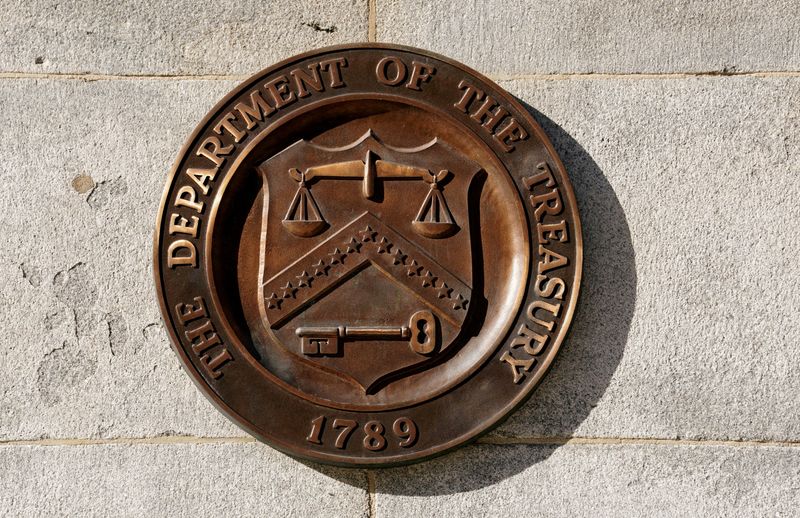By Karen Brettell
(Reuters) - The U.S. Treasury Department on Wednesday said it will slow the pace of increases in its longer-dated debt auctions in the November 2023 to January 2024 quarter and expects it will need one more additional quarter of increases after this to meet its financing needs.
Treasury yields fell after the announcement on relief the increases were not as large as some had feared. The U.S. government on Monday cut its borrowing estimate for the October-December quarter to $776 billion -- $76 billion less than its forecast in July.
Yields on benchmark 10-year Treasury notes were about 8 basis points lower on the day, dropping below 4.8% for the first time in about two weeks.
Treasury has been increasing auction sizes to fund a budget deficit which is increasing due to several factors such as higher government spending, fueled in part by rising interest payments on federal debt stemming from the Federal Reserve's interest rate increases and quantitative tightening.
Monday's borrowing estimate, however, came in less than expected partly because income tax payments from some states deferred due to natural disasters were now starting to flow in.
"It wasn’t as bad as feared. The guidance that there may be only one more quarter where it increases was somewhat comforting," said Brian Jacobsen, chief economist at Annex Wealth Management in Menomonee Falls, Wisconsin.
The issuance details were announced hours ahead of the Federal Reserve's decision to hold interest rates steady, which added to downward pressure on yields. The Fed left the door open to a further increase in borrowing costs in a policy statement that acknowledging the U.S. economy's surprising strength, but also noted that businesses and households face tighter financial conditions.
The market reaction was in contrast to last quarter when the U.S. government said it expected to borrow $1.007 trillion in the July-September quarter, $274 billion more than it had predicted in May, sparking a large bond sell-off.
EMPHASIS ON MIDDLE DURATIONS
This time, the Treasury focused its largest supply increases in short- and intermediate-dated auctions. Longer-dated debt, which has faced the brunt of the selloff over the past few months, saw more moderate increases.
The Treasury's adjustments were "an effort to calm the panic in bond markets," said Bruce Clark, macro strategist at Informa Global Markets in New York. "They lit a fire in the bond markets in August with the last refunding announcement and now they are attempting to put it out."
The department will increase the size of its 10-year new issue and reopenings by $2 billion, down from $3 billion at the last refunding, and raise its $30-year bond new issue and reopenings by $1 billion, down from the prior increase of $2 billion. The 20-year bond auction sizes will remain unchanged, following an increase of $1 billion last quarter.
Two-year and five-year note auctions will be increased by $3 billion per month, and 3-year and 7-year note auctions will rise by $2 billion and $1 billion per month, respectively.
Joshua Frost, Treasury assistant secretary for financial markets, told a new conference that the decision to slow the growth of longer-dated securities was based on factors including expected borrowing needs and the structural demand for Treasury securities, "all with a goal towards aiming to fund the government at the lowest cost over time."
Frost declined to discuss future revenue projections.
The Treasury plans to sell $112 billion in its quarterly refunding next week. This will include $48 billion in three-year notes, $40 billion in 10-year notes and $24 billion in 30-year bonds.
The government will also increase the size of its two-year floating rate note new issue and reopenings by $2 billion.
Some Treasury Inflation-Protected Securities (TIPS) auction sizes will also be increased, with a $1 billion increase in the December 5-year TIPS auction and January 10-year TIPS auction.
The Treasury also said it expects to implement "modest reductions" to short-dated bill auctions by early December, which are expected to be maintained through mid- to late-January. The bill auctions will be held at current levels through late in November.

Frost acknowledged that there was "robust demand" for bills and that they would likely remain above the 15-20% share of federal debt recommended by the Treasury Borrowing Advisory Committee during the next three months.
It is also considering changing its regular 6-week cash management bill to a benchmark, and will announce this decision at the next refunding. The Treasury added that it continues to make "significant progress" on its plans to launch a regular buyback program in 2024.